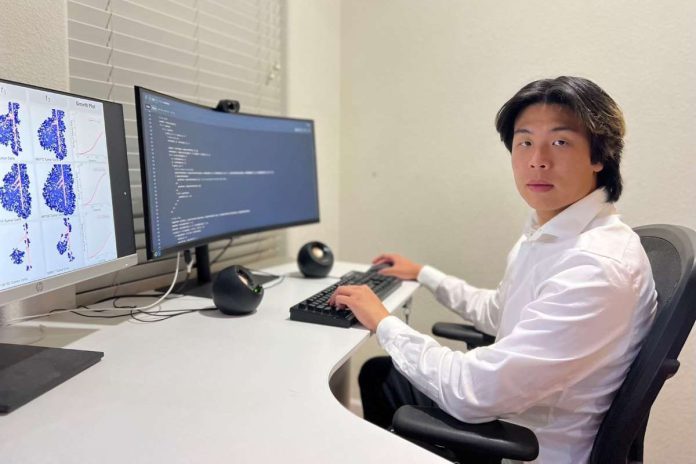When James Gu was young, he watched YouTube videos of LEGO vending machines and thought they were fascinating. That curiosity eventually led him down a path that earned him a $25,000 Davidson Fellows Scholarship for developing a “digital twin” of cancer.
Now a freshman at Stanford University, the 18-year-old BASIS Independent Fremont graduate created MLPA, a framework that uses medical, genetic and imaging data to model how cancer progresses in individual patients. The system could help doctors test personalized treatments virtually and choose the most effective therapies before administering them.
Gu’s fascination with engineering began early. “When I was very small, I loved LEGO robotics,” he said.
Watching YouTube videos led him to the FIRST LEGO League and later to high school robotics competitions. As captain of his FIRST Tech Challenge team, Alphabots 16026, Gu built larger metal robots until curiosity drew him toward something different. “We thought, there’s hard robots, what about soft robots? That was actually a spark—like a research spark.”
That spark became his first science fair project: a millimeter-sized soft robot that could deliver drugs inside the body using magnets. A deeper connection came from home.
“My grandpa unfortunately developed cancer,” Gu said. “He’s okay now, but I was very interested in his research because he was actually a nuclear engineer.”
One of his grandfather’s studies on perturbation theory in nuclear reactors inspired Gu to think about cancer similarly. “I saw parallels in actual cancer modeling,” said Gu. Just as perturbation theory models both the macro-scale reactor and micro-scale fuel rods, he could simulate the macro-scale cancer tumor and the micro-scale individual cancer cells.
This idea became the foundation of MLPA, which simulates how cancer grows, propagates and spreads. “Each patient has very different profiles—genes, weight, gender, history,” Gu said. “The doctor could input all of this data, and it would change how fast the cancer grows or mutates.” Doctors could then use these predictions to tailor treatments or anticipate complications.
The project wasn’t without challenges. “One limitation of my research work was that it is based off of mice data, not human data,” Gu said, since it’s not ethical to leave a human patient untreated to see how their cancer grows. Despite this, Gu persisted, supported by his mentor, Dr. Jake Chen of the University of Alabama at Birmingham—one of many professors he reached out to through cold emails.
“The biggest benefit of a mentor is their experience. They know tools and data sets you might have no clue of,” Gu said.
The “digital twin” goes beyond a simple simulation. Doctors can continuously input patient data and the system adjusts variables like cancer growth rate, spread patterns and mutation behavior.
“The doctor will be able to essentially see a simulation, a week into the future, a month or 10 years into the future, to understand how aggressively they should treat that cancer,” Gu explained.
For Gu, the Davidson Fellows Scholarship is both validation and motivation. “It was a really big validation that high schoolers can actually make meaningful contributions,” he said. “There’s a big assumption that you have to go through tons of schooling to do research, but high schoolers can create something meaningful to society.” It also gave him confidence to approach other labs for further work.
Now at Stanford, Gu plans to major in engineering, exploring intersections between electrical engineering, bioengineering and robotics. Outside of class, he’s working at the Carnegie Institution for Science and joining campus groups like the Stanford Space Initiative and Stanford Student Robotics to continue building and experimenting.
His advice to other young researchers is simple: Don’t underestimate your voice. “High schoolers have a superpower—they can convey ideas in a way others can understand,” he said. “You don’t have to come up with the craziest project title no one understands. You want people to understand what your research is about.”
Looking ahead, Gu envisions a future at the intersection of technology and medicine.
“I just want to keep building—whether it’s a robot, a model or an idea that helps someone. As long as I’m creating something meaningful, I’ll be happy.”





This is a nice article especially since it features someone from Newark, Ca.
It would have been more effective if it had shared where he went to elementary school and if he continued on to Newark Memorial High School.
It would be so amazing for the schools to be recognized.
Just thought I should mention this.